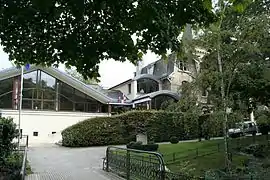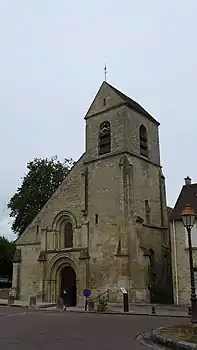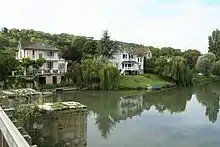Villennes-sur-Seine
Villennes-sur-Seine (French: [vilɛn.syʁ.sɛn] (![]() listen)) is a commune in the Yvelines department in the Île-de-France in north-central France.
listen)) is a commune in the Yvelines department in the Île-de-France in north-central France.
Villennes-sur-Seine | |
|---|---|
 Town hall | |
 Coat of arms | |
Location of Villennes-sur-Seine 
| |
 Villennes-sur-Seine  Villennes-sur-Seine | |
| Coordinates: 48°56′23″N 1°59′55″E | |
| Country | France |
| Region | Île-de-France |
| Department | Yvelines |
| Arrondissement | Saint-Germain-en-Laye |
| Canton | Verneuil-sur-Seine |
| Intercommunality | CU Grand Paris Seine et Oise |
| Government | |
| • Mayor (2020–2026) | Jean-Pierre Laigneau |
| Area 1 | 5.17 km2 (2.00 sq mi) |
| Population (2017-01-01)[1] | 5,282 |
| • Density | 1,000/km2 (2,600/sq mi) |
| Time zone | UTC+01:00 (CET) |
| • Summer (DST) | UTC+02:00 (CEST) |
| INSEE/Postal code | 78672 /78670 |
| Elevation | 19–132 m (62–433 ft) (avg. 19 m or 62 ft) |
| 1 French Land Register data, which excludes lakes, ponds, glaciers > 1 km2 (0.386 sq mi or 247 acres) and river estuaries. | |
Villennes-sur-Seine is located in the Seine Valley just 30 km/20 miles west of Paris. The charming leafy village offers bed and breakfast a rural and relaxed atmosphere while being only a 22-minute train ride away from Paris. The village itself offers an eleventh-century church and ancient grottos.[2] Easy train or auto access allows visitors to reach Versailles, Central Paris and other destinations in the city in just minutes.
History

Saint-Nicholas Church
The construction of the Saint-Nicholas church started in the eleventh century and ended in the twelfth under the initiative of the abbey of Saint Germain-des-Prés. The church served as a parish for the neighboring towns of Médan and Flacourt.
In the hundred years' war the church is partially destroyed leaving the apse and the transept in ruins.
In the eighteenth century, the church is associated with the Coulombs en Eure et Loir abbey and major renovations on the church begin. A complete restoration takes off in 1717.[3]
In 1926, the Saint-Nicholas church is declared a national monument and between 1978 and 1994, the church is completely restored with financing from the state, the department, the region, the commune as well as the association of the restoration and safeguard of church.[4]
Armed forces in Villennes-sur-Seine
- The Rail Road Guards
Commonly referred to as the G.V.C. (Gardes des Voies de Communication), soldiers were stationed in Villennes-sur-Seine to protect the railroad. The military garrison was composed of 25 men who needed lodging and feeding. The restaurant owners of the town were requisitioned to feed the soldiers three meals a day, each consisting of 400g of bread, 100g of meat served with vegetables and wine for two francs per day per soldier.[4]
Seeing that the restaurant owners at the time couldn't afford to feed the whole garrison, the mayor at the time Alfred Laumonier wrote to the state asking the owners be paid back in full.[4]
In November 2014, apartments in Villennes-sur-Seine were allotted to the G.V.C. with heating and living costs to be paid by the town. Eventually, the commune was unable to pay and had to ask residents to provide wood to heat the apartments.[4]
- The Infantry Regime
The presence of the first and second companies of the 286th infantry regime in Villennes-sur-Seine disturbs daily life starting in July 1915. The general of the infantry is housed in the Château d'Aqueville while the soldiers stay with townsfolk on straw or in empty houses.[5]
According to a law written in 1877, house owners hosting soldiers were to provide 850g of wood to each soldier. This law would be the cause of overworking for many villagers. Other issues follow including the sudden overflow of telegrams, resulting in tension between the townspeople and the infantry.[5]
In summer, many villagers have their boats requisitioned for military transport as well as horses and carriages.
After the company's departure in May 1916, the villagers having hosted soldiers received indemnities, some even asking for additional money to cover damages caused by the soldiers.[5]
War Requisitions
Since the beginning of the war, Villennes-sur-Seine is forced to contributed to the nourishment of the army—both men and horses. The mayor attempts to opposite these requisitions as the crops from the only farm in Villennes-sur-Seine are hardly enough for to sustain the needs of the town.[4]
Nonetheless, requisitions for wheat, hay and potatoes only increase.
Moreover, as the war continues, crops are hard to collect as the young men are at war. Therefore, Mr. Laumonier asks to prolong the recruitment of the farmers in Villennes-sur-Seine. He would also bring in soldiers to farm the smaller farms, for harvest season or to pick potatoes and beetroots. For the harvest of 1915, at least twenty soldiers were called.[4]

As the war continues, Villennes-sur-Seine is faced with a wheat shortage. Wheat being the most important crop in the commune, the requisitions demanded by the state cannot be met by the farmers in the town. Once all the wheat is requissioned from the Maroles farm, Mr. Laumonier gets crops brought in from Saint Germain-en-Laye to feed the villagers.[4]
Foreigners in Villennes-sur-Seine
Throughout the war, Villennes-sur-Seine sees little foreigners, with a maximum of 22 at one time. Most are from Alliedcountries such as England, the United-States, Belgium or Italy, but the town shows records of hosting people from Argentina, Brazil and Spain.[3]
On several accounts, the mayor gives to the authorities reports on people from Germany or Austria that had lived in Villennes-sur-Seine. In some cases, if said person is deemed a traitor, their homes were to be boarded up by the commune.[3]
Victims of the War
Starting in November 1914, Villennes-sur-Seine begins to see their villagers die. The first deaths are two brothers from one of the town's smaller farms.[5]
In total, 42 young men from Villennes-sur-Seine died for their country. Amongst them are men from both wealthy and modest backgrounds.[5]
A monument is created in 1919 in their honor.[5]
Interwar period

After the en of the war, the Parisians return to Villennes-sur-Seine and in the span of one summer, the population doubles. They being constructions across the town on many villas; first around the Falaises woods and then on the Island of Villennes. In 1919, Villennes-sur-Seine is considered a tourist station as the whole town is transformed to look more like a resort.[4]
Boating, fishing and swimming in the Seine gain popularity and many parties on the riverside take place. In 1927, l'Île du Platais (otherwise uninhabited) welcomes a new pollution of vacationers in bungalows or tents in the Physiopolis center. The naturalist retreat offers outdoor activities on the water or on the island. Physiopolis brings in consistent amounts of people all throughout the summer and makes Villennes-sur-Seine a recognizable weekend getaway destination for the Parisian upperclass.[4]
World War II
On a night in July 1944, a Germain plane crashes into a house on the Marolles farm, killing a couple in their sleep. The debris spread on a radius of 30 meters and to this day, a pit can be pointed out on the Marolles farm that corresponds to the location of the crash.[4]
The morning of the arrival of the American liberation forces in Villennes-sur-Seine, the 25th of August 1944, German forces present in the town are in search of suspects. Having been attacked the night prior, the soldiers arrest four men and bring them into the basement of a home: Michel and Jacques Jeunet, Alfred Boursinhac and Rodolphe Gerha. The soldiers through grenades at them, killing instantly Rodolphe Gerha and Michel Jeunet. The two others survive but are badly wounded.[4]
Activities in Villennes-sur-Seine

Saint-Nicholas Church
The Saint-Nicholas church is one of the oldest in the Yvelines. It is in the traditional roman style of the eleventh century and is composed of a nave, two aisles and a bell tower. On the inside of the church, decorative columns can be found a well as stained glass windows.[5]
Possible strolls around the town
- Stroll along the Seine
A path along the Seine from the southernmost point of the town to the northernmost goes along the waterway with picturesque views of the water and the old homes of Villennes-sur-Seine.[6]
- L'Île de Villennes
The island, accessible by walking, is home to many old villas along the Seine. Isolated from the main part of town, L'Île-de-Villennes has beautiful views of the water.[6]
See also
References
- "Populations légales 2017". INSEE. Retrieved 6 January 2020.
- Kohn, Michel (2014). Villennes-sur-Seine.
- Mirgon, Marcel. Villennes et ses Seigneurs.
- Kohn, Michel. "L'histoire de Villennes sur Internet".
- Kohn, Michel. Mémoire en images: Villennes-sur-Seine.
- Kohn, Michel. La mémoire de Villennes en marche.
| Wikimedia Commons has media related to Villennes-sur-Seine. |